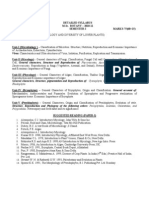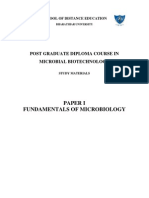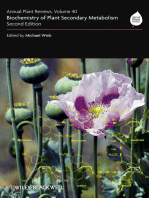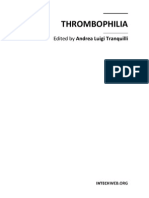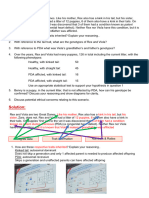0 ratings0% found this document useful (0 votes)
35 viewsScience and Technology Botany
Science and Technology Botany
Uploaded by
Ashwini PanditThe document provides an overview of the Ph.D. entrance exam for the Dr. Babasaheb Ambedkar Marathwada University. It includes:
1. The exam will have two sections - Section A on research methodology worth 50 marks, and Section B on botany worth 50 marks.
2. Section A will cover topics such as research methods, statistical analysis, microscopy, biochemical techniques, plant microtechniques, and computer applications. Section B will cover topics such as cell biology, algae, fungi, bryophytes, pteridophytes, gymnosperms, and palaeobotany.
Copyright:
© All Rights Reserved
Available Formats
Download as PDF, TXT or read online from Scribd
Science and Technology Botany
Science and Technology Botany
Uploaded by
Ashwini Pandit0 ratings0% found this document useful (0 votes)
35 views10 pagesThe document provides an overview of the Ph.D. entrance exam for the Dr. Babasaheb Ambedkar Marathwada University. It includes:
1. The exam will have two sections - Section A on research methodology worth 50 marks, and Section B on botany worth 50 marks.
2. Section A will cover topics such as research methods, statistical analysis, microscopy, biochemical techniques, plant microtechniques, and computer applications. Section B will cover topics such as cell biology, algae, fungi, bryophytes, pteridophytes, gymnosperms, and palaeobotany.
Copyright
© © All Rights Reserved
Available Formats
PDF, TXT or read online from Scribd
Share this document
Did you find this document useful?
Is this content inappropriate?
The document provides an overview of the Ph.D. entrance exam for the Dr. Babasaheb Ambedkar Marathwada University. It includes:
1. The exam will have two sections - Section A on research methodology worth 50 marks, and Section B on botany worth 50 marks.
2. Section A will cover topics such as research methods, statistical analysis, microscopy, biochemical techniques, plant microtechniques, and computer applications. Section B will cover topics such as cell biology, algae, fungi, bryophytes, pteridophytes, gymnosperms, and palaeobotany.
Copyright:
© All Rights Reserved
Available Formats
Download as PDF, TXT or read online from Scribd
Download as pdf or txt
0 ratings0% found this document useful (0 votes)
35 views10 pagesScience and Technology Botany
Science and Technology Botany
Uploaded by
Ashwini PanditThe document provides an overview of the Ph.D. entrance exam for the Dr. Babasaheb Ambedkar Marathwada University. It includes:
1. The exam will have two sections - Section A on research methodology worth 50 marks, and Section B on botany worth 50 marks.
2. Section A will cover topics such as research methods, statistical analysis, microscopy, biochemical techniques, plant microtechniques, and computer applications. Section B will cover topics such as cell biology, algae, fungi, bryophytes, pteridophytes, gymnosperms, and palaeobotany.
Copyright:
© All Rights Reserved
Available Formats
Download as PDF, TXT or read online from Scribd
Download as pdf or txt
You are on page 1of 10
Dr.
BABASAHEB AMBEDKAR MARATHWADA UNIVERSITY, AURANGABAD
Ph.D. (Botany) Entrance Test
Section A Research Methodology (Revised in 2020)
Index
Section Subject Marks
Section A Research Methodology 50
Section B Botany (Unit-I to V) 50
Unit-I Cell Biology & Molecular Biology, Cytology and Genetics
Biology and Diversity of Algae, Fungi and Microbes, Bryophytes,
Unit-II Pteridophytes, Gymnosperms and Palaeobotany
Taxonomy of Angiosperms, Plant Development & Reproduction,
Unit-III Bioprospecting and Plant Resource Utilization
Plant Anatomy, Plant Physiology and Metabolism & Ecology and
Unit-IV Conservation
Unit-V Biotechnology, Genetic Engineering and Bioinformatics
Section - A
Research Methodology
UNIT- I:
1. Introduction of Research: Meaning of Research, its importance, aims and objectives,
Identification and criteria of selecting a Research Problem (Hypothesis), literature
collection, Research Plan and its components, Methodology (Experimental design / Field
data collection). Data presentation and interpretation. Drawing conclusions.
2. Scientific paper writing – Manuscript preparation and presentation.
3. Research Journals, Impact Factor and paper citation index.
4. Major Research Institutes related to Plant Sciences in India. A brief idea about
Government Research and funding agencies, as DST, DBT, ICAR, ICMR, CSIR, UGC,
CST, etc.
5. IPR and Patenting.
UNIT-II:
6. Statistical Methods: Standard deviation, Standard error, Co-efficient of variation, Null
Hypothesis, level of significance, Chi-square Test, ‘t’-Test and ‘F’-Test, Analysis of
Variance for one-way and two-way classified data.
7. Principles of Microscopy (Light microscope, phase contrast, Electron Microscope (SEM
& TEM) and Fluorescence microscope).
8. Biochemical techniques- Principles and methodology of colorimetry, spectrophotometry,
pH meter, centrifugation, basic principles underlying different types of centrifuges.
Chromatography – partition, thin layer, adsorbtion, sephadex, ion exchange, gas liquid
chromatography, HPLC.
UNIT- III:
9. Plant Micro technique – Fixatives and staining (single and double). Fixation for
histological and histochemical study. Microtomy.
10. Histochemical methods in Pharmacognosy and Forensic Botany. Organoleptic evaluation
of market drugs.
11. Preparation of Cytological slides for study of Mitosis and Meiosis
12. Field and Herbarium techniques.
UNIT- IV:
13. Culture of Algae: Media and isolation of pure cultures.
14. Culture and preservation of Fungi.
15. Plant tissue culture methods. Genetic transformation methods (Agrobacterium-mediated
and microprojectile / Biolistic methods).
16. Soxhlet extraction, Column chromatography, TLC, High pressure liquid Chromatography
(HPLC), Electrophoresis and ELISA.
17. Principles of Fluorescence, UV, Visible, NMR and Atomic Absorption Spectroscopy and
Autoradiography.
18. Basic concepts of Recombinant DNA technology. Gene cloning, DNA fingerprinting
technique, Polymerase Chain Reaction and Southern blotting.
UNIT – V.
19. Ethical and Legal issues of Research: Authentication of specimens, Legal permissions for
collection of biological material from Local Biodiversity committees, Forest Department,
State Biodiversity Board and National Biodiversity Authority.
20. Computer applications: MS Office- Word, Power point Presentation, Excel, Popular Image
Formats. Connecting to the Internet, Browsing the Web, Searching for Information,
literature and research papers, Downloading, Sending and Receiving Email
21. Photography: Principles and methods of digital photography, photomicrography and
image analysis.
Books Recommended (SECTION – A)
1. Arora, J.R.. Madhan Mohan, T., Rajendran, G.J., Kannan, S. And Nambiseshan, S. 1993.
Research Profile of Biotechnology Activities in India-A Directory. PID, New Delhi.
2. Banerjee, P.B. 2014. Introduction to Biostatistics. S.Chand & Company Pvt. Ltd., New
Delhi, India.
3. Bhattacharya, D.K. 2013. Research Methodology, Excel Books, New Delhi. 5
4. Chandel, S.R.S. 1999. A Handbook of Agricultural Statistics. Acha Prakashan Mandir,
Kanpur, India
5. Dhopte, A.M. and Livera-M, M. 1989. Useful Techniques for Plant Scientists. Publication
of Forum for Plant Physiologist, R.D.G. College, Hostel-1, Akola-444001(M.S.), India.
6. Freeze, J.T. 2000. Sams’ Teach yourself: Computer Basics. Macmillan Computer Pub,
USA with Techmedia Pub, New Delhi.
7. Gupta, V. 2014. Rapidex Computer Course. Pustak Mahal, Delhi.
8. Harborne J.B. 1998. Phytochemical Methods - A Guide To Modern Technique of Plant
Analysis, 3rd edn, Champan & Hall, UK.
9. Heldt, Hans-Walter. 2005. Plant Biochemistry. Academic Press- an Imprint of Elsevier,
New Delhi, India.
10. Jain S. K. and R. R. Rao. 1977. Handbook of Field and Herbarium Techniques. Today and
Tommorrows Printers and Publishers, New Delhi.
11. Kothari, C.R. and Garg, G. 2014. Research Methodology: Methods and Techniques. New
Age International Publishers, New Delhi, India.
12. Kumar, R. 2012. Research Methodology: A Step-By-Step Guide for Beginners. SAGE
Pub. India Pvt. Ltd., New Delhi.
13. Panse, V.G. and Sukhatme, P.V.1985. Statistical Methods for Agricultural Workers.
Indian Council of Agricultural Research, New Delhi, India.
14. Singh, V.P. and Purohit, S. 2003. Research Methodology in Plant Sciences. Scientific
Publishers (India), Jodhpur.
15. Snell, N. 1998. Sams’ Teach yourself: The Internet Starter Kit. Macmillan Computer Pub,
USA with Techmedia Pub, New Delhi.
16. Sundararaj, P. And Siddu, A. 1995. Qualitative Tests and Quantitative Procedures in
Biochemistry. Wheeler & Co. Ltd., New delhi, India.
17. Swain T. 1963. Chemical Plant Taxonomy, Academic Press London
18. Wilson K and John Walker, 1999. Principles and Techniques of Practical Biochemistry,
Cambridge University Press.
Botany Syllabus of Paper II
(Revised 2020)
Sr.
Name of The Unit Detailing
No.
01 Cell Biology & Molecular 1.Cell Biology: Organization of plant cell and
Biology, Cytology and chloroplast, mitochondria, Golgi complex, Nucleus,
Genetics Ribosomes, Endoplasmic Reticulum, Cell wall, Cell
membrane, vacuoles, cytoskeleton, The structure and
role of RNA,Totipotency, differentiation and cell
death, cell cycle, apoptosis, Cell signalling.
2.Molecular Biology: Chromosome organization, DNA
replication and repair, Chromatin organization,
protein synthesis, transcriptional and translational
regulation,Protein targeting, Computer assisted
chromosome analysis.
3.Genetics and Plant Breeding: Mendelian genetics,
concept of gene, Linkage and recombination, genetic
mapping, extra chromosomal inheritance,
chromosome banding, Chromosomal abberations,
Mutation, FISH and GISH , Microbial genetics, phage
genetics, linkage and crossing over, recombination,
homologous and non-homologous linkage maps, 3
point test cross, tetrad analysis in yeast and
Neurospora. Selection-Mass and Pure line selection,
hybridisation-Backcross and Test cross, Heterosis
breeding, Mutation breeding, role of polyploidy in
plant breeding, genetically engineered plants.
02 Biology and Diversity of 1. Algae: Introduction of phycology, Algae in
Algae, Fungi and Microbes, diversified habitats, Systems of classification of algae,
Bryophytes, Pteridophytes, General account of thallus organization, reproduction
Gymnosperms and and life history of algae, General account, cell
Palaeobotany structure and method of reproduction in Cyanophyta;
Chlorophyta; Xanthophyta; Bacillariopyta;
Phaeophyta and Rhodophyta, Algal blooms, Role of
Algae in human welfare, biofertilizer.
2. Fungi: General Characters, Classification, Economic
importance of fungi, Fungi as plant pathogen, General
account of different groups and type study of fungi as
pathogen - Mastigomycotina; Ascomycotina,
Basidiomycotina and Deuteromycotina.
3. Bacteria: General characters, ultrastructure,
classification, Koch’s postulates, archaebacteria and
eubacteria. Role of agrobacterium in GM crops. Citus
canker, Angular leaf spot of cotton.
4. Phytoplasma: General Account, ultrastructure and
economic importance of Grassy shoot of sugarcane.
Little leaf of brinjal.
5. Viruses: General account, ultrastructure and
economic importance of viruses. TMV, Papaya leaf
curl.
6. Bryophytes: Systems of classification, distribution,.
Habitat, Economic importance, external and internal
morphology, reproduction, gametophytes and
sporophytes, phylogeny and interrelationships of the
orders: Sphaerocarpales, Takakiales, Marchantiales
and Jungermanniales, Anthocerotales, Sphagnales,
Andreales and Bryales.
7. Pteridophyta: Classification, Origin and evolution,
Phylogenetic relationship with Bryophyta,
Morphology, anatomy, phylogeny and
interrelationships of the orders Psilotales,
Psilophytales, Lycopodiales, Selaginellales, Isoetales,
Equisetales and Filicales. Sporophyte and
gametophyte in Pteridophytes, Stelar organization and
evolution, Origin of leaf and Telome concept,
Sporocarp, Heterospory and seed habit.
8. Gymnosperms: Introduction, Classification and
distribution of Gymnosperms, Morphology, anatomy,
reproduction, phylogeny of the orders
Pteridospermales, Bennettitales, Cycadales,
Ginkgoales, Coniferales, Taxales and Gnetales,
Economic importance of gymnosperms.
9. Palaeobotany: Introduction, Contributions of Prof.
Birbal Sahani, Geological time scale, Fossils and
fossilization, Continental drift/ plate tectonics.
03 Taxonomy of 1. Angiosperms: Aims, objectives and scope of
Angiosperms, Plant taxonomy, Nomenclature and classification.
Development & Taxonomic literature, Evolutionary trends and
Reproduction, variations, IUCN, phylogenetic classifications, APG
Bioprospecting and Plant system of classification, species concepts, speciation,
Resource Utilization Biosystematics, biosystematics categories.
2. Plant Development: Vegetative and reproductive
development in plants, organization of plant
structures, Regulation of plant development by
intrinsic and extrinsic factors(light, Hormones).
Molecular aspects of development.
3. Reproduction: Flower, Pollination, Male and Female
Gametophyte, Seed Development and Fruit growth.
4. Bioprospecting and Plant Resource Utilization:
Ethnobotany, types of Bioprospecting,
Phytochemicals used in aroma, flavour and medicines,
plant resources and natural products, Exploration of
lower and higher plant forstandardization of herbal
medicines as per US-FDA.
04 Anatomy, Plant Physiology 1. Anatomy: Plant as Unique Organisms, History and
and Metabolism & tools of Plant Anotomy, Cellular Plant Anatomy,
Ecology and Conservation Vascular Tissues, Primary and Secondary , vegetative
growth, Flowering and Reproduction.
2. Plant Physiology and Metabolism : Water relations
and membrane transport, photosynthesis and
respiration, nitrogen metabolism, Lipid Metabolism,
hormones, Stress physiology and tolerance
mechanisms, strategies used for development of stress
resistant / tolerant plants.
3. Ecology and Conservation:Ecosystem- structure,
types and functions, Ecological succession, habitat,
biomes, Biomes, population ecology, plant
interactions, phytogeography, Biodiversity,
endemism, RET species, IUCN categories, Ecological
modelling Niche, evolution and co-evolution,
Diversity types.Strategies of Conservation. Biological
Diversity Act 2002.
05 Biotechnology, Genetic 1. Biotechnology, Engineering and Bioinformatics:
Engineering and Plant tissue culture techniques, Micropropagation,
Bioinformatics cell, tissue andorgan culture, Elicitation and secondary
metabolites production. Enzymes in genetic
engineering, cloning vectors, Agrobacterium mediated
gene transfer, characterization of transformants, Gene
libraries, DNA sequencing, Introduction to Genomics
and Proteomics, PCR and RTPCR techniques.
2. Bioinformatics Databases: Primary sequence
databases (GenBank-NCBI, the nucleotide sequence
database-EMBL, DNA sequence databank of Japan-
DDBJ; Protein sequence and structure databases
(PDB, SWISS-PROT and TrEMBL); Derived
(Secondary) Databases of Sequences and Structure:
Prosite, PRODOM, PRINTS, Pfam, BLOCK, SSOP,
and CATH. Enzyme Database, Biodiversity Database.
Unit Botany Reference Books
UNIT-I 1. Lewin, B. (2000). Genes VII. Oxford University Press,
New York, USA.
Cell Biology & Molecular
2. Lewis, R. (1997). Human Genetics: Concepts and
Biology, Cytology and
applications (2nd ed), WCB, McGraw Hill, USA.
Genetics
3. Burjes, J. (1985). "An Introduction to Plant cell
development Cambridge University Press, Cambridge.
4. Lewin, B. (2000). Genes VII. Oxford University Press,
New York, USA.
5. Lewis, R. (1997). Human Genetics: Concepts and
applications (2nd ed), WCB, McGraw Hill, USA.
6. Burjes, J. (1985). "An Introduction to Plant cell
development Cambridge University Press, Cambridge.
7. Priyadarshan, P.M. (2019). Plant Breeding:
Classical to Modern. Springer Singapore
UNIT-II 8. Chapman V.J. and Chapman, D.J. (1983) The Algae,
The MacMillan Press Ltd., London.
Biology and Diversity of
9. Desikachary T.V. (1959) Cyanophyta, 1CAR, New
Algae, Fungi and Microbes,
Delhi.
Bryophytes, Pteridophytes,
10. Fritsch F.E. (1961) The Structure and Reproduction of
Gymnosperms and
the Algae, Vol. I & H, Cambridge University Press,
Palaeobotany
London.
11. Kumar, H.D. (1988) Introductory Phycology,
Affiliated East-West Press Pvt. Ltd., New Delhi.
12. Sinha, U. and Sheela Shrivastava (1985) An
Introduction to Bacteria, Vikas Publishing House Pvt.
Ltd., New Delhi.
13. Burgey's Manual of Systematic Bacteriology, Vol. 1-
4(1986-1989) Williams & Wilkins, Baltimore.
14. Verma, J.P. (1992) The Bacteria, Malhotra Publishing
House, New Delhi,
15. Salle, A.J. (1974) Fundamental Principles of
Bacteriology, Tata McGraw Hill Publishing Co. Ltd.,
New Delhi.
16. Alexopoulous C.J., Mims, C.W.and Blakwel, M.
(1996) - Introductory Mycology, John Wiley & Sons
Inc.
17. Dube H.C. (1994) - An Introduction to Fungi, Vikas
Publishing House, New Delhi.
18. Mukadam D.S. (1997) ‘The Illustrated Kingdom of
Fungi’, Aksharganga Publication, Aurangabad.
19. Agashe, S. N. (1995) Paleobotany, Oxford & IBH,
New Delhi Bir, S. S. (2005) Pteridophytes their
Morphology, Cytology, Taxonomy and Phylogeny.
Today & Tomorrow's Printers & Publisher.
20. Biswas, C. and Johri, B.M. (2004) The Gymnosperms,
Narosa Publishing House, New Delhi
21. Coulter J. M. and Chamberlain, C.J. (1978)
Morphology of Gymnosperms, Central Book Depot,
Allahabad
22. Eames, A. J. (1974) Morphology of Vascular Plants-
lower groups, Tata Me Graw-Hill Publishing Co. New
Delhi.
23. Parihar, N. S. (1991) Bryophytes, Central Book Dept.,
Allahabad.
24. Parihar, N. S. (1976) The biology and morphology of
the pteridophyta, Central Book Depot, Allahabad.
25. Prem Puri (1973). Bryophytes: A Broad Perspective.
Atma Ram and Sons, New Delhi.
26. Rashid, A. (1976) An introduction to Pteridophyta,
Vikas Publishing House Ltd., New Delhi.
27. Sambamurty, A. V. S. S. (2005) A Textbook of
Bryophytes, Pteridophytes, Gymnosperms and
Paleobotany, Today & Tomorrow's Printers and
Publishers
28. Ramkrishna, P. S. (2001) Ecology and Sustainable
Development. National Book Trust, New Delhi.
29. Nikias, K. J. (1981). Paleobotany, Paleoecology and
Evolution. Praeger Publishers, USA
30. Shukla, A. C. and Mishra, S. P. (1982). Essentials of
Paleobotany. 2nd ed. Vikas Publishing House Pvt. Ltd.,
New Delhi.
31. Hale, M. E. Jr. (1983). Biology of Lichens. Edward
Arnold, Maryland
UNIT-III 32. Davis, P.H. and Heywood, V.H. (1973). Principles of
Angiosperms Taxonomy. Robert E. Krieger Pub. Co.
Taxonomy of Angiosperms,
New York.
Plant Development &
33. Grant, W.F. (1984). Plant Biosystematics, Academic
Reproduction,
Press, London.
Bioprospecting and Plant
34. Harrison, H.J. (1971). New concepts in Flowering Plant
Resource Utilization
Taxonomy. Hieman Educational Book Ltd.,London.
35. Heywood, V.H. and Moore, D.M. (1984).Current
Concepts in Plant Taxonomy, Academic Press, London.
36. Radford, A.E. (1986). Fundamentals of Plant
Systematics. Harper & Raw Publications, USA.
37. Hopkins WG. (2006). The Green World: Plant
Development, Chelsea House Publication
38. Howell SH. (1998) Molecular Genetics of Plant
Development, Cambridge University Press.
39. Sharma, P. D. (2001) Ecology and Environment,
Rastogi Publications. Meerut.
40. Lawrence, G. H. M. 1951. Taxonomy of Vascular
Plants. The Macmillan Company. New York.
41. Naik, V. N. (2000). Taxonomy of Angiosperms. Tata
McGraw-Hill Publishing Company Limited, New
Delhi.
42. Arora, R.K. and Nayar, E.R. (1984), Wild relatives of
crop plants in India, NBPGR Science MonographNo.7.
43. Baker, H.G. (1978), Plants and civilization. Ill Ed. (A.
Wadsworth, Belmount).
44. Bole, P.V. and Vaghani, Y. (1986). Field guide to
common Indian trees, Oxford University Press,
Mumbai.
45. Thakur, R.S., Puri, H.S. and Husain, A. (1969). Major
medicinal plants of India, Central Institute of medicinal
and aromatic plants, Lucknow.
46. Swaminathan, M.S. and Kocchar, S.L. (Es.) (1989).
Plants and Society, MacMillan Publication Ltd.,
47. Sharma, O.P. (1996). Hills Economic Botany, Tata
McGraw Hill co., Ltd., New Delhi.
48. Kocchar, S.L. (1998). Economic Botany of the tropics,
2nded. MacMillan India Ltd.,
49. Sharma, P. P. and Singh, N.P. (2001). Ethnobotany of
Dadra Nagar Haveli and Daman (UT), Publ. BSI,
Kolkata.
UNIT-IV 50. Richard Crang, Sheila Lyons-Sobaski and Robert Wise
(2018). Plant Anatomy: A Concept-Based Approach to
Plant Anatomy, Plant
the Structure of Seed Plants. Springer International
Physiology and Metabolism
Publishing, Switzerland AG.
& Ecology and Conservation
51. Cutter EG (1978) Plant Anatomy, Part I & II, Edward
Arnold, United Kingdom.
52. Esau, K, 1965. "Plant Anatomy" (2nd ed; 7th reprint
1991), Wiley Eastern, New Delhi.
53. Fahn A (1974) Plant Anatomy, Pergmon Press, USA &
UK.
54. Salisbury, F.N. and Ross, C.W. Plant Physiology, 3rd
Edition (2006): CBS Publishers and Distributors, New
Delhi.
55. Lehninger, A.L. Principles of Biochemistry, CBS
Publishers and Distributors, New Delhi. 3.
56. Bidwell, R.G.S. (1974) Plant physiology, Mac Millan
Publishers Co.,New York.
57. Devlin, R.M. and Hostan, F.H., Plant physiology, CBS
Publishers and Distributors, New Delhi.
UNIT-V 58. David Clark and Nanette Pazdernik (2015).
Biotechnology. 2nd ed. Publ.Academic Press.
Biotechnology, Genetic 59. Gupta, V., Sengupta, M., Prakash, J., Tripathy, B.C.
Engineering and (2017). Basic and Applied Aspects of Biotechnology
Bioinformatics Publ. Springer Singapore.
60. Henry, R.J. Practical application of plant molecular
Biology, Champman and Hall.
61. Kalyan kumar De (2008). Introduction to Plant Tissue
culture, New Central Book Agency.
62. Bhojwani, S.S. M.K. Razdan (1996). Plant Tissue
Culture. Publisher, Elsevier Science
63. Montell S.H. Mathews, J.A., Meker, R.A. Principles of
Plant Biotechnology.
64. Glover, D.M. and Hanes, B.D. (eds.) 1995. DNA
cloning 1: A practical approach, core techniques , 2nd
edition, PAS, IRL press at Oxford University Press.
65. Smith, R.H. 2000. Plant Tissue culture: Techniques and
Experiments. Academic Press, New York.
66. Ramsden, Jeremy (2015). Bioinformatics An
Introduction. Publ. Springer-Verlag London.
67. Supratim Choudhuri (2014). Bioinformatics for
Beginners. 1st ed. Publ.Academic Press.
68. Godbey, W.T. (2014). An Introduction to
Biotechnology.Publ. Academic Press
69. Chawla H. S. (2017). Introduction to Plant
Biotechnology 3rd ed. Publ. Oxford & Ibh Publishing
Name & Signatures of Syllabus Committee:
Dr. Ashok M. Chavan Dr. Vikram Khilare Dr. P.P. Sharma
Professor Professor Principal
(Chairman) (Member) (Member)
Date:
Place: Aurangabad
You might also like
- Full download Genetics Essentials Concepts and Connections 5th Edition Benjamin Pierce pdf docxDocument50 pagesFull download Genetics Essentials Concepts and Connections 5th Edition Benjamin Pierce pdf docxdaveylloyds100% (3)
- Microbiology HonoursDocument24 pagesMicrobiology HonoursRajat kumar vimalNo ratings yet
- Syllabus For Botany - PGDocument3 pagesSyllabus For Botany - PGSVB 2018No ratings yet
- Ph.D. Entrance Test SyllabusDocument3 pagesPh.D. Entrance Test Syllabusprabhnotdbg18No ratings yet
- Nep Core 1st SemDocument10 pagesNep Core 1st Sembgg27822No ratings yet
- Botany Syllabus For Indian Forest Service Examination 2010 Paper-I 1. Microbiology and Plant PathologyDocument3 pagesBotany Syllabus For Indian Forest Service Examination 2010 Paper-I 1. Microbiology and Plant PathologyanniemehtaNo ratings yet
- Syllabus of Plant BiotechnologyDocument5 pagesSyllabus of Plant BiotechnologyAnonymous MFChsONo ratings yet
- sem2 syllabusDocument4 pagessem2 syllabusmjmaheta77No ratings yet
- PG Botany SyllabusDocument13 pagesPG Botany SyllabusManasNo ratings yet
- UPSC IFS Botany Syllabus: Paper - IDocument3 pagesUPSC IFS Botany Syllabus: Paper - IVikram Singh ChauhanNo ratings yet
- 301-Life SciencesDocument2 pages301-Life SciencesdevikatanikantiNo ratings yet
- 4.2 Botany PET SyllabusDocument6 pages4.2 Botany PET SyllabusMoinuddin VakilNo ratings yet
- CSJMU Question PaperDocument147 pagesCSJMU Question Papersumitp2313No ratings yet
- Botany-1Document8 pagesBotany-1mm muruganNo ratings yet
- TS EAMCET AM SyllabusDocument24 pagesTS EAMCET AM SyllabushoNo ratings yet
- 1-Cell and Molecular Biology of PlantsDocument95 pages1-Cell and Molecular Biology of PlantsSubhash ChandNo ratings yet
- Optional Subject: Botany Paper - I (300 Marks / 3 Hours) : 1) Microbiology and Plant PathologyDocument2 pagesOptional Subject: Botany Paper - I (300 Marks / 3 Hours) : 1) Microbiology and Plant PathologyPrasanta SarmaNo ratings yet
- Pre PH.D CoursesDocument114 pagesPre PH.D CoursesAhmed Khalid HussainNo ratings yet
- Research Biochemistry 1819Document11 pagesResearch Biochemistry 1819gpt.iprNo ratings yet
- B.Sc. BotanyDocument13 pagesB.Sc. Botanyr prathapNo ratings yet
- Botany Syllabus For PG Assistant (Source Internet)Document4 pagesBotany Syllabus For PG Assistant (Source Internet)Selvaraju ParthibhanNo ratings yet
- Semester II ReferencesDocument7 pagesSemester II ReferencesPawan ElleNo ratings yet
- Syllabus - AM PDFDocument28 pagesSyllabus - AM PDFSampath NanduNo ratings yet
- Syllabus - Agriculture and PharmacyDocument28 pagesSyllabus - Agriculture and Pharmacydasari.raghavaraghavaNo ratings yet
- Ph.D. Course Work in BOTANY - 2019 PDFDocument2 pagesPh.D. Course Work in BOTANY - 2019 PDFBhagirath Gogikar100% (1)
- M.sc. (Botany) SyllabusDocument42 pagesM.sc. (Botany) SyllabusPriyankNo ratings yet
- BSC Biotechnology Iii Year SyllabusDocument16 pagesBSC Biotechnology Iii Year Syllabuskarli geethanjaliNo ratings yet
- Upsc Syllabus Botany OptionalDocument6 pagesUpsc Syllabus Botany OptionalHARSH RANJANNo ratings yet
- AM - Syllabus TSEAMCET 2022Document32 pagesAM - Syllabus TSEAMCET 2022ayesha tabassumNo ratings yet
- Principles of Plant BiotechnologyDocument152 pagesPrinciples of Plant BiotechnologyDhanupriya Suresh Kumar100% (1)
- Supportive Syllabus-12.9.17Document102 pagesSupportive Syllabus-12.9.17David MillerNo ratings yet
- MSC MicrobiologyDocument13 pagesMSC MicrobiologyShravani SalunkheNo ratings yet
- Biology I ST Grade 12122013Document5 pagesBiology I ST Grade 12122013Nitendra TomarNo ratings yet
- Botany 2023 Batch ContentsDocument4 pagesBotany 2023 Batch Contentszuhaibullah97No ratings yet
- Life Sciences SyllabusDocument4 pagesLife Sciences SyllabusConflicted ConundrumNo ratings yet
- Microbial GeneticsDocument129 pagesMicrobial Geneticsk7260827No ratings yet
- M.SC - Medical Biotechnology - 1st To 4th Sem Session 2011-12Document36 pagesM.SC - Medical Biotechnology - 1st To 4th Sem Session 2011-12Prassu SwtyNo ratings yet
- Syllabus 2023Document23 pagesSyllabus 2023vedant chaudhariNo ratings yet
- Syllabus 2023Document21 pagesSyllabus 2023indianmelacommunityNo ratings yet
- CSJMU MSC Zoology SyllabusDocument7 pagesCSJMU MSC Zoology SyllabusAbdul WassayNo ratings yet
- Botany Paper-I 1. Microbiology and Plant PathologyDocument3 pagesBotany Paper-I 1. Microbiology and Plant PathologyAbhimanyu PandeyNo ratings yet
- 95-04-22-21-32-45Document485 pages95-04-22-21-32-45k41162No ratings yet
- Life ScienceDocument5 pagesLife ScienceAbprez KimsingNo ratings yet
- BotanyDocument8 pagesBotanyanitameena9376286250No ratings yet
- Biotechnology-Document5 pagesBiotechnology-6632ronithkoundinyaNo ratings yet
- BS_ZOOLOGY_outline_7thDocument7 pagesBS_ZOOLOGY_outline_7thsky268383No ratings yet
- Syllabus For MSCDocument3 pagesSyllabus For MSCTushar AmetaNo ratings yet
- Updated Syllabus - BoS - B.Sc. Hons. AgricultureDocument96 pagesUpdated Syllabus - BoS - B.Sc. Hons. AgricultureAnuragNo ratings yet
- Syllabus ListDocument129 pagesSyllabus ListNeelakanta AngadiNo ratings yet
- Fund MicroDocument311 pagesFund MicroHussam HassanNo ratings yet
- Micro 103 Lecture ScheduleDocument2 pagesMicro 103 Lecture ScheduleRavneetNo ratings yet
- BotanyDocument23 pagesBotanyswadhin.nayak859No ratings yet
- B.sc. (Botany)Document15 pagesB.sc. (Botany)All in OneNo ratings yet
- MSc Syllabus Sem-1Document8 pagesMSc Syllabus Sem-1Deep KumarNo ratings yet
- Plant Omics: Advances in Big Data BiologyFrom EverandPlant Omics: Advances in Big Data BiologyHajime OhyanagiNo ratings yet
- Endophyte Biotechnology: Potential for Agriculture and PharmacologyFrom EverandEndophyte Biotechnology: Potential for Agriculture and PharmacologyAlexander SchoutenNo ratings yet
- Fungi: Biology and ApplicationsFrom EverandFungi: Biology and ApplicationsKevin KavanaghNo ratings yet
- Annual Plant Reviews, Biochemistry of Plant Secondary MetabolismFrom EverandAnnual Plant Reviews, Biochemistry of Plant Secondary MetabolismNo ratings yet
- In Vitro Propagation and Secondary Metabolite Production from Medicinal Plants: Current Trends (Part 2)From EverandIn Vitro Propagation and Secondary Metabolite Production from Medicinal Plants: Current Trends (Part 2)No ratings yet
- Obesity and MetabolismDocument305 pagesObesity and Metabolismsavvy_as_98100% (2)
- BSHORHDocument73 pagesBSHORHshivendra.dangi2022No ratings yet
- Get Genetics: Analysis and Principles, 7th Edition Brooker PDF ebook with Full Chapters NowDocument40 pagesGet Genetics: Analysis and Principles, 7th Edition Brooker PDF ebook with Full Chapters Nowazhammphela100% (5)
- 4 Principle of GeneticsDocument27 pages4 Principle of Geneticsbansallove2008No ratings yet
- Zoology 466 - M. Sc. I, II SemDocument11 pagesZoology 466 - M. Sc. I, II SemNeeraj GuptaNo ratings yet
- Unit 3-GeneticsDocument81 pagesUnit 3-GeneticsGeetika DuaNo ratings yet
- BIOL 1121 Assignment Activity Unit 7Document7 pagesBIOL 1121 Assignment Activity Unit 7Phil PhilNo ratings yet
- Thrombo PhiliaDocument226 pagesThrombo PhiliawalkerbestNo ratings yet
- Syllabus For M.Sc. in Zoology (Semester With CBCS)Document28 pagesSyllabus For M.Sc. in Zoology (Semester With CBCS)anurag kumarNo ratings yet
- 6th TestDocument15 pages6th Testownwillprincess2No ratings yet
- Scoliosis: Causes, Genetics, Symptoms, and Treatment in A Southern Italy PopulationDocument48 pagesScoliosis: Causes, Genetics, Symptoms, and Treatment in A Southern Italy PopulationKirolos WassefNo ratings yet
- Get Applied Genetics of Humans Animals Plants and Fungi 2nd edition Bernard C. Lamb PDF ebook with Full Chapters NowDocument50 pagesGet Applied Genetics of Humans Animals Plants and Fungi 2nd edition Bernard C. Lamb PDF ebook with Full Chapters Nowparboqaderwa100% (7)
- Classical Genetics Edit1 PDFDocument10 pagesClassical Genetics Edit1 PDFSalma AhmedNo ratings yet
- Linkage & RecombinationDocument76 pagesLinkage & RecombinationshivamalikejiNo ratings yet
- Exercise MemosDocument44 pagesExercise MemosthandithaliaNo ratings yet
- University of Zimbabwe: G E N E T I C SDocument49 pagesUniversity of Zimbabwe: G E N E T I C SKhufaziera KharuddinNo ratings yet
- 4369232Document46 pages4369232Mahmuda LevineNo ratings yet
- Scaling Test - JawaharDocument12 pagesScaling Test - JawaharJawahar JawaharNo ratings yet
- 12-BIOLOGY QUESTION BANK (With Value Based Questions) - 1Document33 pages12-BIOLOGY QUESTION BANK (With Value Based Questions) - 1venkatesh kumarNo ratings yet
- FullDocument235 pagesFullpaul onyeudoNo ratings yet
- 2017 AOS2 Inheritance WorkbookDocument46 pages2017 AOS2 Inheritance WorkbookkevintranresearchNo ratings yet
- 01sex LinkageDocument25 pages01sex LinkageRon BuenaNo ratings yet
- Extra Nuclear InheritanceDocument13 pagesExtra Nuclear InheritanceTony BernardNo ratings yet
- AQA A Level Biology November 2021 Paper 2 MSDocument16 pagesAQA A Level Biology November 2021 Paper 2 MSnesiaroberts903No ratings yet
- Kelainan KromosomDocument78 pagesKelainan KromosomBiil Dpo100% (1)
- Gene Mapping: Biology 20Document5 pagesGene Mapping: Biology 20Soham SenguptaNo ratings yet
- A General Method of Detecting Additive, Dominance and Epistatic Variation ForDocument7 pagesA General Method of Detecting Additive, Dominance and Epistatic Variation Forsupriya chhotarayNo ratings yet
- Csir Net Colored SyllabusDocument40 pagesCsir Net Colored SyllabusSATYARANJAN SETHINo ratings yet
- Agricultural BiotechnologyDocument40 pagesAgricultural BiotechnologyMateoTabaresNo ratings yet








